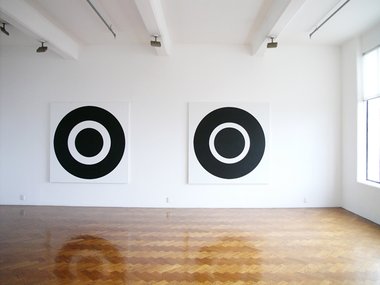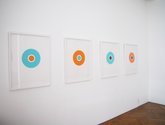John Hurrell – 17 June, 2011
You have to look very carefully at the black and white images to detect their individuality, partly because in the case of the paintings you get confused by shadowy blurry after-images resulting from the high tonal contrasts, and in the case of the small photographs, the black frames have unique thicknesses too.
In this restrained but elegant exhibition of paintings, photographs and screenprints by the late Julian Dashper we see works linked to his characteristic drum skin and record sleeve abstractions, concentric circles that (besides referencing Kenneth Noland and Jasper Johns paintings) could also be pulsing suns or cross sections of electrical wiring - symbolising the transmission of energy from an artistic practice.
The large front gallery is taken up with two black and white paintings and four black and white photographs, with four brightly coloured screenprints in the small back room. All the works have an inner white ‘negative’ circle that serves as a thin glowing buffer between inner core and outer rim.
You have to look very carefully at the black and white images to detect their individuality, in the manner say of examining Allan McCollum sculptures, partly because in the case of the paintings you get confused by shadowy blurry after-images resulting from the high tonal contrasts, and in the case of the small photographs, the black frames have unique thicknesses too.
With the two large paintings, one has the inner white circle having half the thickness of the outer black circle, whilst the other has the white circle’s thickness being a third of the outer rim. With the prints the main colours are Dashper’s characteristic hues (for circles) turquoise and bright orange, complementaries that are tonally matched, with the unsettling addition of black (centre core only).
This is a fun show to check out, if only for the gruntiness of the large canvases, and the pleasure of analysing the ratio of the thicknesses of the circular bands. The screenprints are nice because of their chroma, but I prefer the related (but absent) circular drum parts because of their scale, their avoidance of a rectangular support, and their shiny plasticity of surface.
John Hurrell
Recent Comments
Martin Langdon
I agree with the better effectiveness of a circular support to help take the viewer to a world of possibility ...







 Two Rooms presents a program of residencies and projects
Two Rooms presents a program of residencies and projects Advertising in this column
Advertising in this column



This Discussion has 1 comment.
Comment
Martin Langdon, 10:50 p.m. 20 June, 2011 #
I agree with the better effectiveness of a circular support to help take the viewer to a world of possibility rather then left looking through a window containing the possible.
Love the visuals and what a fun exhibition.
Participate
Register to Participate.
Sign in
Sign in to an existing account.